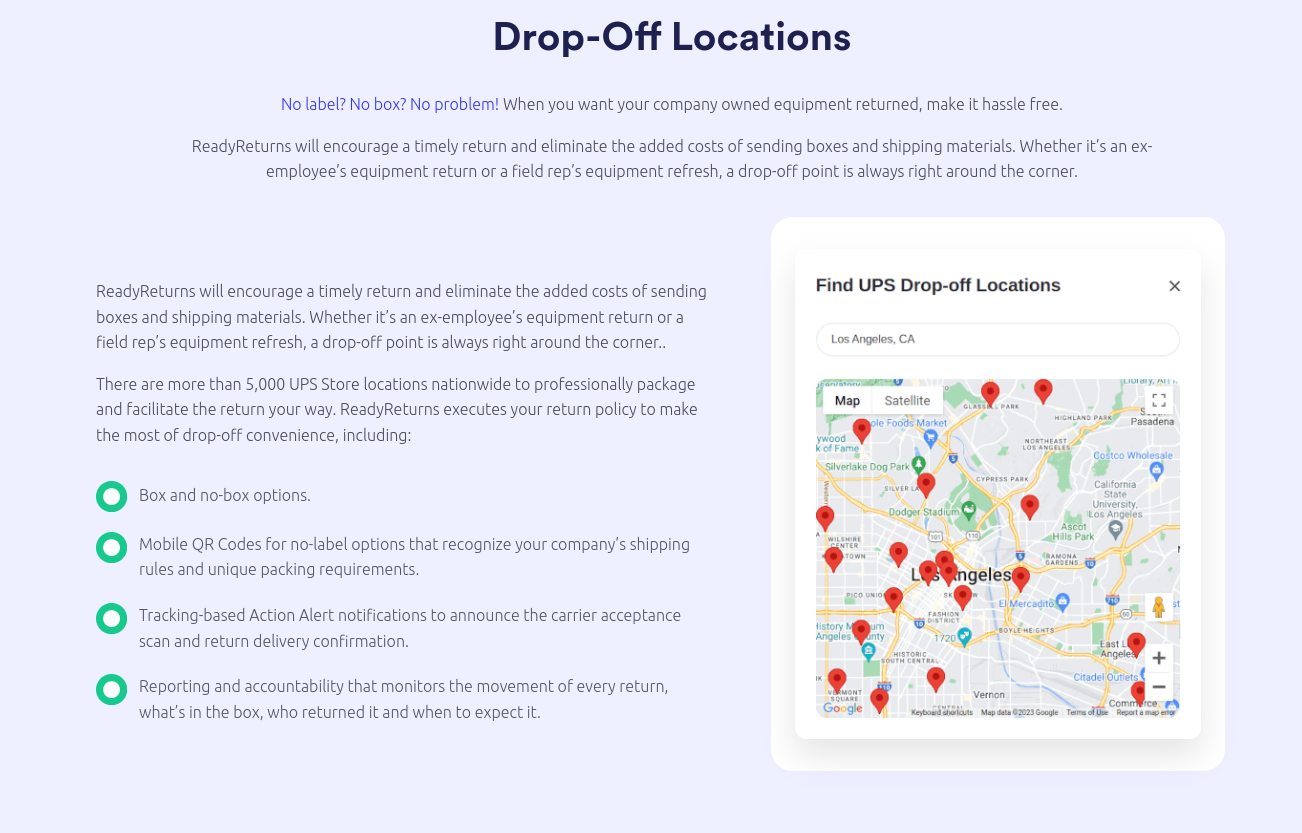Terminated Employee Not Returning Company Equipment? Here Are Some Options

Disclaimer: The information provided in this blog is for general informational purposes only and is not intended as legal advice. Nothing in this content should be construed as a substitute for advice from qualified legal counsel. Always consult with a licensed attorney regarding your specific legal situation or concerns.
According to the most recent statistics, with high turnover and distributed teams, company-issued equipment is traveling farther and staying out longer. Laptops, phones, access badges, uniforms, software keys, hard drives, and furniture are being sent to employees nationwide. But what happens when those employees are terminated and don’t return your company’s property?
It’s a growing issue. Not every offboarding process ends smoothly, and some former employees are slow—or flat-out refuse—to return equipment. This is not just an inconvenience; it’s a compliance and security risk, and it could cost your company time, money, and even sensitive data.
Here’s what you need to know.
What Happens When a Terminated Employee Doesn’t Return Company Property?
Most cases start the same way. An employee is let go or resigns. They’re expected to return their equipment within a set window of time. But then… nothing. Emails go unanswered. Boxes never arrive. Or, worse, you hear from someone that the ex-employee is still using your laptop or accessing company systems.
This puts your organization at risk on multiple levels. Aside from the monetary value of the hardware, there’s also exposure from:
- Unauthorized access to systems
- Potential data leaks
- Delays in reassigning equipment
- Loss of intellectual property
Not every delay is malicious. Sometimes people forget or misunderstand the process. However, in cases of outright refusal, employers have every right to take action.
Failure to Return Company Property Laws: What You Need to Know
Here’s the catch: no single federal law governs the return of employer property. Instead, the legal approach depends on your state’s labor code and property laws.
Still, a few things are crystal clear:
- All employer-issued equipment belongs to the company.
- If an employee fails to return it, the company can pursue reimbursement.
- Civil or criminal charges can be filed if theft or intent to deprive is proven.
States may differ in how they let employers recover the value—some allow payroll deductions (with prior consent), others don’t. But businesses are within their rights to seek the return of property or its replacement value.
Can You Withhold the Final Paycheck Until Property Is Returned?
Here’s where things get tricky.
Some employers assume they can hold onto an employee’s final paycheck until that laptop or badge is back in their hands. That’s not always legal.
In states like California, for example, withholding final wages is strictly prohibited—even if the employee still has company property. On the other hand, Texas and Florida allow wage deductions if there’s a signed agreement or company policy in place.
Furthermore, withholding wages can lead to wage violation claims, so it’s best to check state-specific laws before making any decisions.
A better approach is to have clear, signed policies during onboarding that outline how missing property will be handled, including whether final pay may be adjusted if the equipment isn’t returned.
How to Get Equipment Back from a Terminated Employee
The first step is always communication.
Start by sending a polite but direct email or letter reminding the former employee of what they need to return, when, and how. If you have the option, include a prepaid return label or offer a convenient drop-off point; make returning equipment like computers simple.
Here are a few tips to increase your success rate:
- Make the process as frictionless as possible.
- Send clear instructions with photos or a checklist.
- Include a specific return-by date (usually within 5–10 business days).
- Offer tracking or return receipt options to confirm when it’s en route.
Keep all communication documented. If things escalate, you’ll want a paper trail to show that you made a good-faith effort to recover the property before taking further action.
Sending a Failure to Return Company Property Letter
If polite reminders aren’t working, it’s time to send a formal Failure to Return Company Property Letter.
This letter should include:
- A detailed list of items not yet returned
- The original return deadline
- Instructions for returning the property immediately
- A warning about potential legal consequences
Keep the tone professional and straightforward. Don’t be overly aggressive, but don’t beat around the bush. You’re entitled to your property; your former employee should know you’re taking it seriously.
Here’s what companies need to consider when handling laptop returns securely.
- Data Security: Companies handling confidential information must ensure returned laptops are wiped or securely handled.
- Liability Protection: Using a service with tracking and insurance reduces the risk of lost or damaged devices.
- Compliance with Regulations: Certain industries require certified disposal and data destruction for IT assets.
Why Choose ReadyCloud’s Equipment Return Software?
- Automated Asset Return Workflows: Eliminate the need for manual tracking and follow-ups. ReadyCloud automates the entire return process, providing real-time updates and reducing the risk of errors.
- Enhanced Visibility: Gain full transparency into each return. Know what equipment is being returned, by whom, and when to expect it, allowing for better planning and resource allocation.
- Seamless Integration: ReadyCloud integrates effortlessly with your existing systems, ensuring a smooth transition and minimal disruption to your operations.
- User-Friendly Interface: Both employees and administrators will find the platform intuitive, making the return process straightforward and hassle-free.
 Key Features:
Key Features:
- QR Code Returns: Simplify the return process with QR codes that employees can use at over 5,000 UPS Store locations nationwide. No need for boxes or labels—just scan and return.
- Real-Time Tracking: Monitor the status of each return from initiation to completion, ensuring accountability and timely processing.
- Customizable Policies: Tailor the return process to fit your company’s specific needs, including setting deadlines, defining acceptable conditions, and more.
- Comprehensive Reporting: Access detailed reports to analyze return patterns, identify bottlenecks, and make informed decisions to improve your asset management strategy.
Benefits to Your Organization:
Implementing a streamlined equipment return process offers several key benefits that protect your bottom line, safeguard company data, and improve operational workflows.
- Cost Savings: Reduce expenses associated with lost or unreturned equipment and minimize the need for replacements.
- Improved Security: Ensure sensitive data is protected by promptly retrieving devices from departing employees.
- Enhanced Compliance: Maintain adherence to company policies and industry regulations with a documented and transparent return process.
- Increased Efficiency: Free up your HR and IT teams to focus on strategic initiatives rather than manual tracking and follow-ups.
When to Talk to a Lawyer
If the former employee intentionally refuses to return valuable property, and your documentation supports that, you can escalate to local law enforcement or file a civil claim. Just understand that many police departments view this as a civil issue rather than criminal unless there’s proof of theft. In any case, you’ll want to talk to qualified legal counsel to learn your options.
Before going this route:
- Gather evidence: signed agreements, email exchanges, and inventory lists.
- Calculate the value of the unreturned property.
- Consult with legal counsel.
Some companies skip court altogether and hire third-party collections to recover the asset or its monetary value. This can be effective, but it should always be a last resort.
How Long Do Employees Have to Return Company Property?
A standard return window is 5 to 10 business days from the termination date. This gives enough time for the employee to gather items and arrange shipping or drop-off.
Set the deadline in writing—ideally in the termination letter or during the exit interview. And remember to remind them before and after the date. Gentle nudges work better than silence.
Without a deadline, it becomes harder to enforce consequences or prove refusal.
What About Remote Employees Not Returning Equipment?
This is becoming a huge problem.
Remote workers don’t have a manager stopping by their desk on their last day. They might be in another state or another country. You can’t exactly walk into their home and pick up your laptop. You need a process in place that works for everyone involved.
That’s why shipping logistics are crucial here. Employers should:
- Provide prepaid return labels and clear instructions.
- Include tracking and insurance on return shipments.
- Create a digital checklist so the employee confirms each item before shipping.
- Revoke system access remotely, or use device management tools to lock down equipment.
Remote returns aren’t impossible, but they require planning, automation, and a bit of strategy.
Creating an Employee Equipment Return Policy
The best offense is a good defense.
A solid employee equipment return policy makes all of this smoother. This policy should be included in your employee handbook and acknowledged with a signature during onboarding.
Your return policy should cover:
- A complete list of company-issued items
- Expected return timelines post-termination
- Who to contact with questions
- Language about possible payroll deductions (if allowed by your state)
- Replacement cost liability
Reinforce the policy during performance reviews, promotions, and especially during offboarding.
Setting Clear Expectations Around Equipment Returns
Don’t wait until the exit interview to talk about returning gear.
Set the tone early by:
- Including your return policy in the offer letter or orientation packet
- Having employees sign an equipment agreement that lists each item issued
- Reviewing that list regularly and updating it as devices are upgraded or added
On the employee’s last day, go through each item line by line and remind them of their return deadline. It only takes five minutes, but it could save you weeks of chasing gear.
Establishing a Company Equipment Return Solution
Manual tracking with spreadsheets? That’s a recipe for chaos.
Instead, use an automated solution that tracks asset assignments, streamlines shipping, and integrates with HR platforms.
Top features to look for:
- Serial number or asset tag tracking
- Employee ID associations
- Built-in return workflows with deadlines
- Auto-generated shipping labels
- Email and SMS reminders
- Escalation alerts if deadlines are missed
Using a return solution improves compliance and frees up your team’s valuable time by removing the manual legwork.
Make Returning Company Property After Termination Easy for Offboarded Workers
Let’s face it—some people just need the process easy.
Here’s how to eliminate common excuses:
- Offer multiple return methods: drop-off, mail-in, or pickup (if local).
- Keep communication clear, consistent, and professional.
- Offer a small perk for prompt returns (like waiving fees or including a gift card).
- Reinforce that returning equipment is a standard part of exiting a job, not a punishment.
Employees are more likely to follow through when the return process feels effortless.
Protecting Company Property Starts with Process
It’s a headache no business wants: a terminated employee holding onto company hardware. But it doesn’t have to turn into a legal mess.
Clear policies, consistent communication, and the right technology can streamline the entire return process. Most employees will comply when expectations are documented and the logistics are simple.
For the few that don’t? You’ve got options—legal and otherwise.
Ready to Simplify Equipment Returns? ReadyCloud Makes It Easy
ReadyCloud’s suite of eCommerce tools includes a dedicated Equipment Returns Software Solution that makes asset recovery trackable and straightforward. Whether you’re managing returns from remote teams or enforcing hardware handoffs post-termination, ReadyCloud helps you:
- Automatically issue QR codes to terminated employees. No box, no label, no problem.
- Track each asset by serial number or employee ID.
- Send thoughtful, automated follow-ups.
- Maintain an auditable record of the return process.
- Integrate equipment return tracking into your HR and shipping workflows.
Stop chasing down company property. Let ReadyCloud do the heavy lifting.
→ Learn more about ReadyCloud’s Equipment Returns Solution here
Disclaimer: The information provided in this blog is for general informational purposes only and is not intended as legal advice. Nothing in this content should be construed as a substitute for advice from qualified legal counsel. Always consult with a licensed attorney regarding your specific legal situation or concerns.
What You Should Do Now
Offboarding remote employees? Need your company devices back? Here are three ways we can help you retrieve devices from remote employees:
Schedule a Demo – If you want to recover remote employee devices without sending a box or label, just a QR code, schedule a demo of ReadyCloud IT Asset Retrieval. We’ll tailor the session to your company’s needs and address any questions.
Integrate with Your Current Tools – Install the ReadyCloud IT Asset Retrieval app directly in your ServiceNow, Jira, or Freshservice instance to issue QR codes from your existing workflows. Have a custom system? Contact us for our headless API.
Get the Free Guide – Unveil the 7 critical pitfalls companies encounter when recovering remote employee IT assets, and prevent costly mistakes, low recovery rates, and wasted resources.
Share On:





